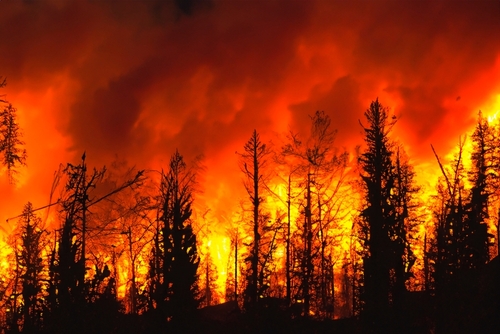Editor’s note: FM Perspectives are industry op-eds. The views expressed are the authors’ and do not necessarily reflect those of Facilities Management Advisor.
Spring has arrived in much of the United States: flowers are budding, and frosty mornings are giving way to longer, sunnier days. With these changes comes another, less-welcome seasonal threat: wildfires, which produce excessive smoke that results in poor air quality conditions for Americans.

Already, smoke from the Texas panhandle wildfire has raised nationwide concern over our country’s ability to manage the fires and their effects—including dangerous smoke and particles that penetrate indoor and outdoor air. Not even a year ago, much of the continental U.S. faced black, smoky skies as Canadian wildfires blazed out of control. This year, we need to better prepare for the health risks presented by these fires to keep our communities safe and healthy.
During a wildfire or similar climate emergency, the concentration of dangerous particles in the air increases to treacherous levels. Smoke exposure in the U.S. has increased 27-fold over the last decade, and nearly 41% of schools reported issues with HVAC systems in 2020. Even after the COVID-19 pandemic—which significantly raised the public’s consciousness of what’s in the air they breathe—U.S. public schools earned a D+ for poor infrastructure conditions, including HVAC, air quality, ventilation, and other facility factors. The continued climate crisis will only exacerbate these conditions by putting further pressure on outdated school infrastructure.
Officially, wildfire season begins in late spring and peaks in August—just as children are returning to classrooms—and tapers off in October. However, as the climate warms and becomes more unpredictable, the season itself may begin to stretch longer. Educational facilities need robust air quality monitoring and preparedness measures to preserve children’s learning environments no matter what is going on outside the walls of the classroom.
Effective emergency preparedness in learning environments requires a multifaceted approach. Planning and resource allocation must begin proactively—long before any environmental threats are imminent—and include relevant members of the community, such as building operators, school administrators, students, and staff. If these conditions are met, schools can adapt easily rather than scramble to find solutions while their students, educators, administrators, and staff suffer.
Investing in these changes now will be less costly in the long run, rather than refusing to adapt and having to make expensive repairs after the damages are done. Severe weather events have caused over $8 billion of property damage in the education sector over the past decade. In comparison, resilient infrastructure and technology solutions can withstand and recover from emergencies at a much lower cost. In comparison, resilient infrastructure and technology solutions can withstand and recover from emergencies at a much lower cost. For instance, real-time indoor air quality monitors are not expensive when bought in bulk and can prevent costly repairs later. The technology monitors the efficiency of HVAC systems, quality of indoor air, and volatile organic compounds that may disrupt learning. It’s not as glamorous as a shiny new facility, but glamor isn’t the point: A small investment now will improve children’s health outcomes and enable our future generations to learn effectively.
Facilities managers should collaborate with building occupants to develop and implement emergency response protocols, as well as instruct hands-on workshops on how to read online dashboards. However, emergency preparedness is not a one-and-done endeavor. By providing training on best-practice procedures, schools will be better prepared to handle the inevitability of another air quality crisis.
In addition, facilities managers must prioritize ongoing monitoring, evaluation, and adaptation to ensure the effectiveness of emergency preparedness efforts over time. This involves regularly reviewing and updating emergency response plans in light of changing circumstances, emerging threats, and lessons learned from previous incidents. By adopting a proactive and adaptive approach to facilities management, educational institutions can stay ahead of the curve and effectively mitigate the risks posed by climate-change-related disasters.
Children have a right to their education, even during a climate emergency, and it’s time facilities learn to mitigate problems associated with them. By prioritizing risk assessment ahead of time, schools can lessen the cost of climate emergencies later down the line. Infrastructure resilience, training, education, collaboration, and ongoing adaptation will enable schools to prevent unwanted effects that climate change disasters can have on students and staff. In the face of an increasingly uncertain climate future, it is imperative that we prioritize emergency preparedness for learning environments now more than ever.
Dr. Serene Almomen is the co-founder and CEO of smart building technology company Attune.
The post Emergency Preparedness for Climate Disasters: Overcoming Hurdles in Schools appeared first on Facilities Management Advisor.







0 Comments